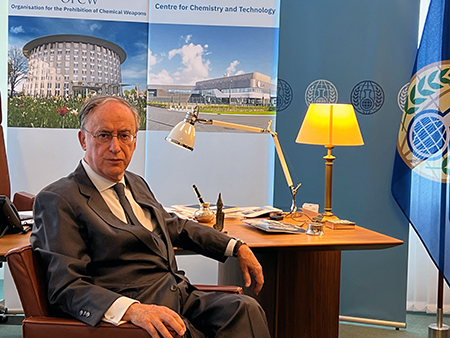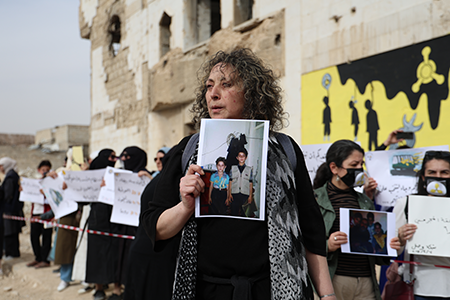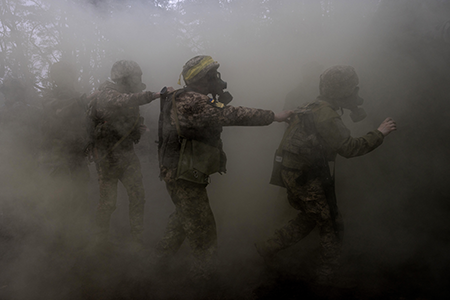The OPCW Is More Necessary Than Ever
June 2025
By Fernando Arias
The Organisation for the Prohibition of Chemical Weapons (OPCW) is an international organization made up of 193 states that are parties to the Chemical Weapons Convention (CWC), a treaty that entered into force in April 1997.

By joining the CWC, the states-parties have committed themselves to the total elimination of all stockpiles of chemical weapons, abiding thus by the principles of zero tolerance and accepting the stringent OPCW verification system. As a result, after 28 years of OPCW efforts, more than 72,000 metric tonnes of chemical weapons declared by the states-parties have been irreversibly destroyed.
In 2023, the destruction of all declared chemical weapons was hailed as a great success, and a sign that the ethical and political taboo against the use of chemical weapons remains strong among states-parties.
The notion that chemical weapons are abhorrent and have no place in today’s world is firmly accepted and represents a consolidated understanding. In recent years, chemical weapons have been used in some countries, but their use has never been acknowledged by the perpetrators because of the strong taboo against their use.
Beyond the destruction of declared chemical weapons, the OPCW’s other main activities have included regular inspections of chemical industry sites, international cooperation and capacity-building programs, scientific research, and various types of investigations and assistance provided to the states-parties.
The purely technical nature of the organization’s mandate requires a strong corps of staff equipped with top-notch expertise in various scientific and technological fields. At the same time, because the membership is made up of states-parties, the OPCW also possesses a highly visible diplomatic component, directly affected by the political positions adopted by the states-parties in their capitals and conveyed to the organization through their respective ambassadors.
When the CWC was negotiated, some relevant stakeholders believed that following the elimination of all declared chemical weapons stockpiles, the OPCW could be shut down or downsized to a very small Secretariat, as the core goal of destruction would have been reached.
But given the recent significant advances in science and technology, as well as the unstable global world order, the organization is now more necessary than ever.
Today, emerging technologies provide new and powerful instruments that offer clear advantages, yet also pose serious risks. Drone technology, for example, has increased the ability to widely disseminate chemicals, while nanotechnology offers the possibility to reduce significantly the size of laboratories. With the advent of 3D printing technology, laboratory equipment now can be produced locally while avoiding international trade scrutiny.
Nanotechnology has reduced the size of laboratories and automation systems have boosted the capacity of chemical production. These developments also have allowed reductions in the number of staff with access to sensitive information, making it much more difficult to detect illicit production. Moreover, quantum computing with the necessary programs has become instrumental in the design of new chemicals. Together with artificial intelligence, the efficiency and power of these new technologies has increased exponentially.
In this context, the use of the internet in its various forms, including the dark web, has facilitated access—sometimes illegal—to equipment, chemical substances, different sorts of instruction manuals, and expert advice.
 All of these new technical features present new risks and threats that create a far more complex and difficult environment to manage than the one in which the recently concluded destruction of classic chemical weapons took place.
All of these new technical features present new risks and threats that create a far more complex and difficult environment to manage than the one in which the recently concluded destruction of classic chemical weapons took place.
The most effective way to tackle these new threats is by ensuring there is always a combination of robust expertise in the OPCW Secretariat and that the OPCW agenda has the active support of the states-parties.
In this respect, the organization already has at its disposal a powerful instrument in the OPCW Centre for Chemistry and Technology, a facility inaugurated by King Willem-Alexander of the Netherlands in May 2023.
The center was designed specifically to keep pace with the rapid international progress in science and technology. It is composed of a modern laboratory, multiuse training areas featuring state-of-the-art equipment, classrooms, meeting rooms, and a multipurpose atrium to cater to different types of activities.
The center’s potential is high: Many scientific research, training, and international-cooperation activities already are taking place there, and many more will be carried out in the coming years.
In addition, the Secretariat is paying particular attention to a number of other matters with the Syrian and Ukrainian dossiers being of high relevance.
Our task in Syria is very challenging. Its chemical weapons program became more open to complete elimination after Syrian President Bashar al-Assad was ousted in December 2024, and Ahmad al-Sharaa became the new caretaker president.
The Syrian chemical weapons dossier is a very old one. In 2005, Syria declared to the 1540 Committee of the United Nations that it had no chemical weapons. Eight years later, Syria became a member of the OPCW and declared its chemical weapons program to the organization, fully aware that the details would be verified by OPCW inspectors.
In its initial declaration, Syria listed 27 chemical weapons production facilities and 1,300 metric tonnes of chemical weapons stockpiles that were part of a program that had spanned four decades. All of the declared facilities and chemical agents were inspected by the OPCW and destroyed by the international community under the stringent OPCW verification system. Most of the 1,300 metric tonnes were destroyed outside of Syria.
Soon after Syria’s CWC accession, OPCW inspectors realized that the declaration was neither accurate nor complete. Moreover, there were indications that chemical weapons were still being used by the Assad regime.
To address these outstanding issues, the Secretariat established several special teams dedicated to the Syrian chemical weapons dossier. The Declaration Assessment Team has been in charge of clarifying the initial declaration of Syria, which was incomplete. After 28 rounds of consultations, the initial declaration submitted by the Syrian authorities was amended 20 times, and when the Assad regime fell in December there were still 19 outstanding issues, some of them of a very substantive nature.
The Fact-Finding Mission (FFM) has been responsible for determining whether toxic chemicals have been used as weapons in Syria. At the request of the former Syrian government, the FFM mandate did not include identifying who was responsible for any alleged attacks. The FFM has produced numerous reports confirming that toxic chemicals were used in Syria on repeated occasions.
On August 7, 2015, the UN Security Council adopted Resolution 2235 by consensus, creating the OPCW-UN Joint Investigative Mechanism (JIM) and expressing the determination to identify and hold accountable those responsible for the use of chemical weapons in Syria.
The JIM produced seven reports, attributing four cases of chemical weapons use to the Syrian Armed Forces of the Assad regime and three to the Islamic State. Because of disagreements at the Security Council, the JIM expired in November 2017 as its mandate was not renewed.
The CWC states-parties decided to hold a special session of the OPCW Conference of the States Parties in June 2018. The conference mandated that the OPCW Secretariat continue the task of the JIM, and set up the necessary arrangements to identify chemical weapons perpetrators in Syria.
As a result, the Secretariat decided to set up a new entity known as the Investigation and Identification Team (IIT) which, so far, has produced reports concerning six cases. The Assad regime’s armed forces were identified as chemical weapons perpetrators against the Syrian people in five of the cases and ISIS, in one case.
The role of the OPCW in identifying chemical weapons perpetrators finds its basis in a number of fundamental principles, namely that the use of chemical weapons is reprehensible and the perpetrators of such use in Syria should be held accountable. These principles are in line with the well established positions of the UN Security Council and General Assembly, other UN bodies, and those of a significant number of member states as expressed in their national statements to the UN and the OPCW. The principles also are laid down in the 2015 Ieper Declaration, which was issued for the centennial commemoration of the first large-scale use of chemical weapons during World War I.
Today, these common principles form an undisputed part of customary international law. In several instances, the Security Council has dealt with and discussed the content and findings of the IIT reports, thereby recognizing the role of the OPCW on this matter.
Over the past few years, the General Assembly has adopted resolutions, sponsored annually by Poland, concerning CWC implementation. The resolutions have stated that the individuals responsible for using chemical weapons should be held accountable and stressed the importance of the mandate conferred by the OPCW Conference in 2018 that originated the creation of the IIT.
After Assad’s fall, the OPCW Secretariat established contact with the new Syrian authorities, including with Sharaa and Foreign Minister Asaad al Shaibani. The high-level contacts and the deployments of the OPCW team of experts to Syria have been positive, and the new Syrian authorities, despite the difficult legacy they have inherited, are cooperating well with the OPCW.
The organization has a new and historic opportunity to obtain clarifications on the full extent and scope of the Syrian chemical weapons program. To do so, the Secretariat will need to have access to documents, locations, and people which, in turn, may shed further light on the program.
Establishing a full inventory of the components of the Assad chemical weapons program will be a difficult task, as the new authorities have very little knowledge about it. However, with the financial and political support of the states-parties and the knowledge of the OPCW experts, the organization will carry out this challenging task, visiting a large amount of chemical-weapons-related sites, to assess them, always counting on the goodwill and cooperation of the new Syrian authorities.
 The situation in Ukraine has also required special attention. Since the Russian invasion of Ukraine in 2022, the OPCW has been in contact with diplomats from both countries, which have repeatedly accused the other of using chemical weapons.
The situation in Ukraine has also required special attention. Since the Russian invasion of Ukraine in 2022, the OPCW has been in contact with diplomats from both countries, which have repeatedly accused the other of using chemical weapons.
Upon Ukraine’s request, the OPCW Secretariat has provided assistance and protection programs to several groups of Ukrainian experts, and has already carried out technical assistance visits to Ukraine and produced two reports establishing that banned chemicals have been used on the front lines.
In China, meanwhile, operations continue for the excavation, recovery, and destruction of the chemical weapons abandoned by Japan at the end of World War II.
In the final days of the war, the Japanese Imperial Army, in its retreat, abandoned thousands of chemical weapons munitions in various provinces throughout China. The weapons were buried in pits and have remained there for many years, causing them to physically degrade.
Despite the clear degradation, most of the explosive charges and chemical agents contained in the munitions have been found to be still active. This has rendered the destruction of these abandoned munitions a dangerous, complex, and expensive endeavor.
Thanks to the good cooperation between China, Japan, and the OPCW; significant Japanese financial support; and Chinese logistical support more than 92,000 items of chemical weapons abandoned in China have already been recovered and destroyed, using sophisticated technology in a responsible manner that ensures protection for individuals and the environment. But the task is not yet complete.
As this undertaking has been and continues to be dangerous and complex, the Chinese and Japanese teams responsible for this process must be commended for their determination and courage.
On the global scale, despite the efforts of the states-parties over the last 30 years and the significant accomplishments made, the current situation is very challenging, with the OPCW facing traditional and new risks and threats.
Advances in science and technology provide the organization with new instruments that increase efficiencies, including in our laboratory and in the training of our experts, rendering the investigations and the findings related to alleged chemical weapons use more accurate.
However, advances in science and technology also provide new means for non-state actors to cause harm. In this context, the national implementing measures, namely domestic legislation, adopted by the states-parties is of paramount importance for the responsible implementation of the CWC.
Most states-parties already have enacted comprehensive legislation enabling their law enforcement, customs officials, judiciary, military, chemical industry, and international trade authorities to implement and enforce the obligations under the CWC on the territory of each state-party.
Unfortunately, today, one-third of the members have yet to adopt comprehensive legislation. The Secretariat conducts regular capacity-building activities and promotes international cooperation between states that have already enacted legislation and those that have yet to do so. This includes the sharing of templates of legislation already in force and the exchange of information between legal experts from different states.
Today, the OPCW is an active, responsible, and strong organization that provides concrete results.
Nevertheless, chemical weapons have been used in several countries over the last few years, new technologies present clear risks, and the international global geopolitical situation has produced a dramatically deteriorated security environment, with the international arms control structure facing a difficult moment.
In this context, the OPCW’s future success is not guaranteed. Nations must be reminded that the taboo against using chemical weapons can only be maintained when it is defended in a sustained manner.
